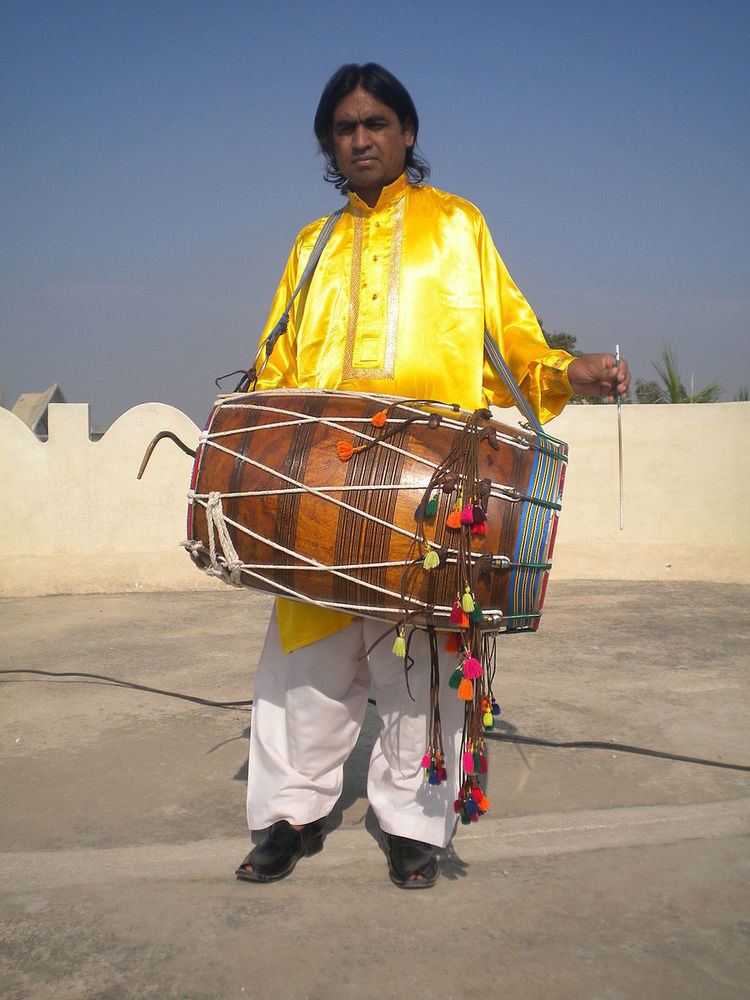 | ||
The term Bhaṅgṛā (Punjabi: ਭੰਗੜਾ , بھنگڑا ; pronounced [pə̀ŋɡɽaː]Listen) refers to the traditional dance originating in the Majha area of the Punjab region; free form traditional Bhangra originating in Punjab, India and modern Bhangra developed by the Punjabi diaspora.
Contents
Traditional Bhangra/Folk dance of Majha
The origins of traditional Bhangra are speculative. According to Dhillon (1998), Bhangra is related to the Punjabi dance 'bagaa' which is a martial dance of Punjab.
However, the folk dance of Majha originated in Sialkot and took root in Gujranwalla, Sheikhupur, Gujrat (districts in Punjab, Pakistan) and Gurdaspur (district in Punjab, India). The traditional form of Bhangra danced in the villages of Sialkot district is regarded as the standard. Although the main districts where traditional Bhangra is performed are in Punjab, Pakistan, the community form of traditional Bhangra has been maintained in Gurdaspur district, Punjab, India and has been maintained by people who have settled in Hoshiarpur, Punjab India after leaving what is now Punjab, Pakistan.
Being a seasonal dance, traditional Bhangra is practiced in the month leading up to the festival of Vaisakhi. During this month, the harvest, especially wheat crop, is reaped. Local fairs mark the festival of Vaisakhi. After days of harvesting and at Vaisakhi fairs, Bhangra is performed, as a dance of men alone.
Traditional Bhangra is performed in a circle and is performed using traditional dance steps. The drum is played according to local beats and is accompanied by singing peculiar to Majha which are folk songs called dhola. The following is an example of a dhola:
ਕੰਨਾ ਨੂੰ ਬੁੰਦੇ ਸਿਰ ਛੱਤੇ ਨੇ ਕਾਲੇ
ਦਹੀ ਦੇ ਧੋਤੇ ਮੇਰੇ ਮੱਖਣਾ ਦੇ ਪਾਲੇ
ਰੱਲ ਮਿਟੀ ਵਿੱਚ ਗਏ ਨੇ
ਸੱਜਣ ਕੌਲ ਨਹੀ ਪਾਲੇ
ਤੇਰੇ ਬਾਝੋਂ ਵੇ ਢੋਲਿਆ
ਸਾਨੂੰ ਕੌਣ ਸੰਭਾਲੇ
Transliteration:
kana noo bunde sir chhate ne kale
dahi de dhote mere makhna de pale
ral mitti vich gaye ne
sajan kol nahi pale
tere bajo ve dholeya
sanu kaun sambhalay
Traditional Bhangra is now also performed on occasions other than during the harvest season and is popular in Pakistan.
Traditional Bhangra has also been imported into the Jammu plains which merge with the plains of Punjab, together with other Punjabi folk dances such as Giddha and Luddi. Punjabi language influences can be observed when people dance such dances in Jammu as the area falls within the Punjab region and shares an affinity with Punjab.
Free form traditional Bhangra
Prior to 1947 Partition of the Punjab region, men of all faiths danced traditional Bhangra. However, after 1947, millions of people were relocated between the new nations of Pakistan and India. Most of the area in which community bhangra is practiced became contained within Pakistan, however the Sikh and Hindu participants moved to Punjab, India where the free form of traditional Bhangra developed.
The 1950s saw the development of the free form traditional Bhangra in Punjab, India which was patronised by the Maharaja of Patiala who requested a staged performance of Bhangra in 1953. The first significant developers of this style were a dance troupe led by brothers from the Deepak family of Sunam (Manohar, Avtar and Gurbachan) and the dhol player Bhana Ram Sunami. Free form traditional Bhangra developed during stage performances which incorporate traditional Bhangra moves and also includes sequences from other Punjabi dances, namely, Luddi, Jhummar, Dhamaal, and Gham Luddi. The singing of Punjabi folk songs, bolian, are incorporated from Malwai Giddha
Free form traditional Bhangra was performed on the national stage for the first time in 1954 on the Republic Day celebrations. Free form Bhangra grew in popularity during the 1950s and was continually developed in India and attained a rather standardized form by the 1970s. Thereafter, the free form traditional Bhangra was exported to other countries by Punjabi emigrants.
Bhangra competitions have been held in Punjab, India for many decades, with Mohindra College in Patiala being involved in the 1950s. They are especially associated with college youth festivals.
Modern Bhangra
By the 1990s, modern Bhangra was being staged in the Punjabi Diaspora, often characterized by a fusion with Western dance styles and the use of prerecorded audio mixes.
Since the 1990s, universities and other organizations have held annual modern Bhangra dance competitions in many of the main cities of the United States, Canada, England, and Australia as well. At these competitions, young Punjabis, other South Asians, and people with no South Asian background compete for money and trophies.
Dress
Women dancing modern Bhangra wear a traditional Punjabi dress known as a salwar kameez, long baggy pants tight at the ankle (salwar) and a long colorful shirt (kameez). Women also wear chunnis, colorful pieces of cloth wrapped around the neck.
These items are all very colorful and vibrant, representing the rich rural colors of Punjab. Besides the above, the bhangra dress has different parts that are listed below in detail:
